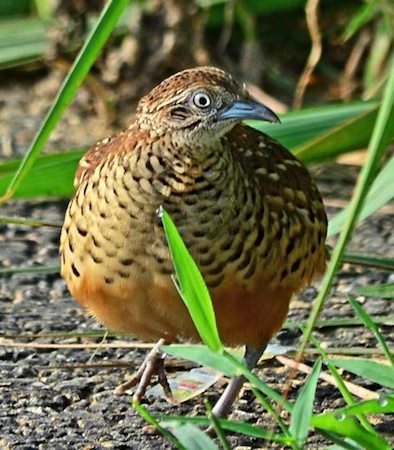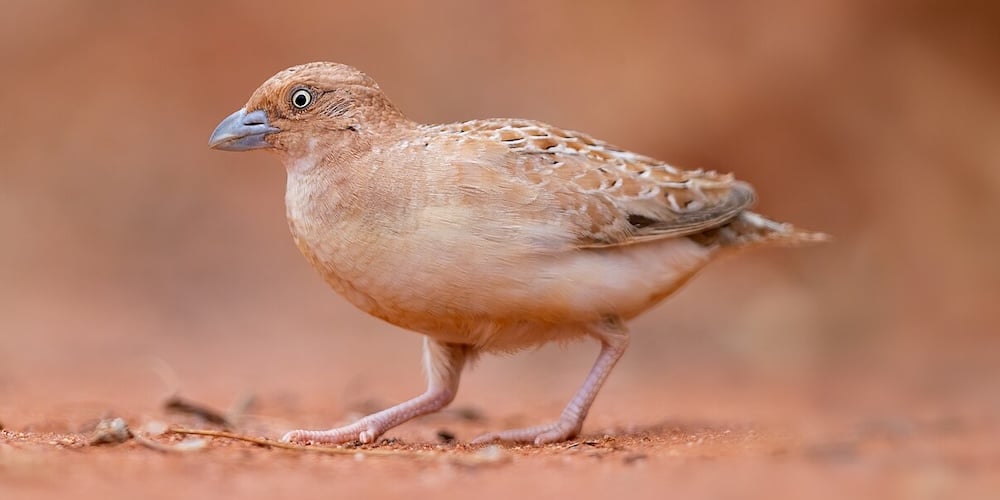Turnicidae – Buttonquails

The Turnicidae (Buttonquails) family is related to the waders, but meritting its own family. The order Charadriiformes also includes Pluvianellidae (Magellanic Plover), Chionidae (Sheathbills), Burhinidae (Thick-knees & Stone Curlews), Pluvianidae (Egyptian Plover), Ibidorhynchidae (Ibisbill), Haematopodidae (Oystercatchers), Recurvirostridae (Stilts & Avocets), Charadriidae (Plovers & Lapwings), Pedionomidae (Plains Wanderer), Thinocoridae (Seedsnipes), Rostratulidae (Painted Snipe), Jacanidae (Jacanas), Scolopacidae (Sandpipers), Dromadidae (Crab-Plover), Glareolidae (Coursers & Pratincoles), Stercorariidae (Skuas), Alcidae (Auks) and Laridae (Gulls, Terns & Skimmers). It contains two genera, although all but one bird are part of the Turnix genus.
They resemble, but are unrelated to, the quails of Phasianidae. They inhabit warm grasslands in Asia, Africa, Europe, and Australia. There are 17 species in two genera, with just one being found in the genus Ortyxelos.

Madagascan Buttonquail Turnix nigricollis – ©Dubi Shapiro
Buttonquails are small, drab, running birds, which avoid flying. The female is the more richly-coloured of the sexes, and initiates courtship. While the Quail-plover is thought to be monogamous, Turnix buttonquails are sequentially polyandrous; both sexes cooperate in building a nest in the earth, but normally only the male incubates the eggs and tends the young, while the female may go on to mate with other males. The eggs hatch after an incubation period of 12 or 13 days, and the young fly within two weeks.
A group of small terrestrial birds; the smallest species is the Quail-plover, which is 10cm in length and weighs only 20g.

Little Buttonquail Turnix velox – ©JJ Harrison CC BY-SA 3.0 via Wikimedia Commons
The buttonquails in the genus Turnix range from 12cm to 23cm in length and weigh between 30g and 130g. They superficially resemble the true quails of the genus Coturnix, but differ from them in lacking a hind toe and a crop. The females of this family also possess a unique vocal organ created by an enlarged trachea and inflatable bulb in the oesophagus, which they use to produce a booming call.
-
Number of bird species: 18
(As at August 2025)
According to the recently (2025) combined AviList, there are 18 species, in two genera in this family. They are:
Quail Plover Ortyxelos meiffrenii
Yellow-legged Buttonquail Turnix tanki
Red-backed Buttonquail Turnix maculosus
Barred Buttonquail Turnix suscitator
Spotted Buttonquail Turnix ocellatus
Common Buttonquail Turnix sylvaticus
Little Buttonquail Turnix velox
Red-chested Buttonquail Turnix pyrrhothorax
Worcester’s Buttonquail Turnix worcesteri
Sumba Buttonquail Turnix everetti
Black-rumped Buttonquail Turnix nanus
Hottentot Buttonquail Turnix hottentottus
Chestnut-backed Buttonquail Turnix castanotus
Buff-breasted Buttonquail Turnix olivii (PE)
Painted Buttonquail Turnix varius
New Caledonian Buttonquail Turnix novaecaledoniae (PE)
Black-breasted Buttonquail Turnix melanogaster
Madagascan Buttonquail Turnix nigricollis
Two species (PE) are possibly extinct.
-
Pheasants, Partridges and Grouse - Including Buttonquails, Sandgrouse and Allies
| By Steve Madge & Phil McGowan | Helm | 2002 | Hardback | 488 pages, 72 col plates, 257 maps | ISBN: 9780713639667 Buy this book from NHBS.com
-
Turnicidae
Family AccountThe buttonquails live in dry tropical and subtropical habitats, including grassland, scrubland, and open woodlands.... -
Turnicidae
Family AccountTurnicidae, which resemble, but are not closely related to, the quails of Phasianidae. They inhabit warm grasslands in Asia, Africa, Europe, and Australia... -
Turnicidae
Family AccountThere are 18 species of small ground-dwelling birds found in this family. Buttonquails are found in warm regions in Europe, Africa, Asia, and Oceania.
Given the number of species in this family, Fatbirder does not provide quick links to all of them. However, the entries below do include links to representatives of both genera and some of the most often encountered, iconic or sought-after species.
-
Barred Buttonquail Turnix suscitator
Species AccountSound archive and distribution map. -
Barred Buttonquail Turnix suscitator
Species AccountThe barred buttonquail or common bustard-quail (Turnix suscitator) is a buttonquail, one of a small family of birds which resemble, but are unrelated to, the true quails. This species is resident from India across tropical Asia to south China, Indonesia and the Philippines. -
Chestnut-backed Buttonquail Turnix castanotus
Species AccountStreaked buttonquail with very heavy pale bill, found in open woodlands, including stony ridges. Heavily patterned, with pale and dark streaks on rich ... -
Chestnut-backed Buttonquail Turnix castanotus
Species AccountThe chestnut-backed buttonquail (Turnix castanotus) is a species of bird in the family Turnicidae. It is endemic to Australia. -
Chestnut-backed Buttonquail Turnix castanotus
Species AccountSound archive and distribution map. -
Common Buttonquail Turnix sylvaticus
Species AccountThe common buttonquail, Kurrichane buttonquail, small buttonquail, or Andalusian hemipode (Turnix sylvaticus) is a buttonquail, one of a small family of birds which resemble, but are unrelated to, the true quails. This species is resident from southern Spain and Africa through India and tropical Asia to Indonesia. -
Common Buttonquail Turnix sylvaticus
Species AccountTurnix sylvaticus is listed as Least Concern. -
Common Buttonquail Turnix sylvaticus
Species AccountSound archive and distribution map. -
Hottentot Buttonquail Turnix hottentottus
Species AccountThe Fynbos buttonquail (Turnix hottentottus) is a bird in the family Turnicidae formerly considered conspecific with the black-rumped buttonquail (Turnix nanus)... -
Hottentot Buttonquail Turnix hottentottus
Species AccountSound archive and distribution map. -
Little Buttonquail Turnix velox
Species AccountThe little buttonquail (Turnix velox) is a species of buttonquail, part of a small family of birds which resemble, but are unrelated to, the true quails. -
Little Buttonquail Turnix velox
Species AccountSound archive and distribution map. -
Madagascan Buttonquail Turnix nigricollis
Species AccountTiny, complexly patterned quail-like bird. Female has rufous sides, gray underparts, and black facial markings. Male is duller and browner. -
Madagascan Buttonquail Turnix nigricollis
Species AccountSound archive and distribution map. -
Quail Plover Ortyxelos meiffrenii
Species AccountA strange long-legged buttonquail that resembles a hybrid between gamebird and shorebird – hence its name. If seen well, the brown-and-cream-scalloped... -
Quail Plover Ortyxelos meiffrenii
Species AccountSound archive and distribution map.
